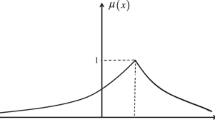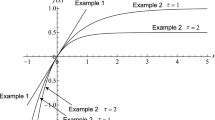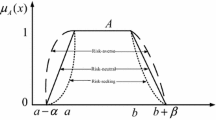Abstract
In recent years, fuzzy optimization has been widely adopted to handle the nonstatistical uncertainties in portfolio selection. Meanwhile, various risk measurements, including variance, entropy and value at risk, have been introduced in fuzzy environments to evaluate portfolio risks from different perspectives. In this study, we discuss fuzzy multi-objective dynamic portfolio optimization for time-inconsistent investors. When building the model, variance and value at risk as the representatives of different types of risk measurements are employed together with the expected return. And a dynamic investment policy is developed for time-inconsistent investors, which combines the expected return and value at risk into one objective. Then, the model is established to maximize the cumulative combined objective function and minimize the cumulative portfolio variance simultaneously. In addition, a multi-objective dynamic evolutionary algorithm is designed as a possible solution of the proposed model. The effectiveness of this research is demonstrated by using a real market data-based case study. Experimental results demonstrate that the proposed model matches the practical behavior of time-inconsistent investors and the solution algorithm is feasible to solve the complicated nonlinear problem.








Similar content being viewed by others
References
Baixauli-Soler JS, Alfaro-Cid E, Fernandez-Blanco MO (2010) Several risk measures in portfolio selection: Is it worthwhile? Span J Finance Account 39(147):421–444
Chen HH, Yang CB (2017) Multiperiod portfolio investment using stochastic programming with conditional value at risk. Comput Oper Res 81:305–321
Chen W, Li SS, Zhang J, Mehlawat MK (2018) A comprehensive model for fuzzy multi-objective portfolio selection based on DEA cross-efficiency model. Soft Comput. https://doi.org/10.1007/s00500-018-3595-x
Clerc M (2006) Particle swarm optimization. ISTE, London
Coello C, Veldhuizen D, Lamont G (2001) Evolutionary algorithms for solving multi-objective problems. Kluwer, Dordrecht
Deb K, Pratap A, Agarwal S, Meyarivan T (2002) A fast and elitist multi-objective genetic algorithm: NSGA-II. IEEE Trans Evol Comput 6(2):182–197
Gao X, Jia L, Kar S (2018) A new definition of cross-entropy for uncertain variables. Soft Comput 22(17):5617–5623
Guo S, Yu L, Li X, Kar S (2016) Fuzzy multi-period portfolio selection with different investment horizons. Eur J Oper Res 254(3):1026–1035
Huang X, Qiao L (2012) A risk index model for multi-period uncertain portfolio selection. Inf Sci 217(24):108–116
Kar MB, Majumder S, Kar S, Pal T (2017) Cross-entropy based multi-objective uncertain portfolio selection problem. J Intell Fuzzy Syst 32(6):4467–4483
Kar MB, Kar S, Guo S, Li S, Majumder S (2018) A new bi-objective fuzzy portfolio selection model and its solution through evolutionary algorithms. Soft Comput. https://doi.org/10.1007/s00500-018-3094-0
Kennedy J, Eberhaart RC (1995) Particle swarm optimization. In: Proceedings of the 1995 IEEE international conference on neural network, vol IV, pp 1942–1948
Li D, Ng WL (2000) Optimal dynamic portfolio selection: multi-period mean–variance formulation. Math Finance 10(3):387–406
Li X, Qin Z, Kar S (2009) Mean–variance–skewness model for portfolio selection with fuzzy returns. Eur J Oper Res 202(1):239–247
Li Y, Wang B, Watada J (2014) Impact evaluation of exit strategy in fuzzy portfolio-based investment. IEEJ Trans Electr Electron Eng 9(5):502–513
Liu YK (2007) The approximation method for two-stage fuzzy random programming with recourse. IEEE Trans Fuzzy Syst 15(6):1197–1208
Liu B, Liu YK (2002) Expected value of fuzzy variable and fuzzy expected value models. IEEE Trans Fuzzy Syst 10(4):445–450
Liu YJ, Zhang WG (2015) A multi-period fuzzy portfolio optimization model with minmum transaction lots. Eur J Oper Res 242(3):933–941
Liu YJ, Zhang WG, Zhao XJ (2018) Fuzzy multi-period portfolio selection model with discounted transaction costs. Soft Comput 22(1):177–193
Mahapatra PK, Ganguli S, Kumar A (2015) A hybrid particle swarm optimization and artificial immune system algorithm for image enhancement. Soft Comput 19(8):2101–2109
Marin-Solano J, Navas J (2010) Consumption and portfolio rules for time-inconsistent investors. Eur J Oper Res 201(3):860–872
Markowitz H (1952) Portfolio selection. J Finance 7(1):77–91
Mostaghim S, Teich J (2003) Strategies for finding good local guides in multi-objective particle swarm optimization (MOPSO). In: Proceedings of the 2003 IEEE swarm intelligence symposium, pp 26–33
Mousavi S, Esfahanipour A, Zarandi MHF (2014) A novel approach to dynamic portfolio trading system using multitree genetic programming. Knowl Based Syst 66:68–81
Qin ZF (2017) Random fuzzy mean-absolute deviation models for portfolio optimization problem with hybrid uncertainty. Appl Soft Comput 56:597–603
Roman D, Darby-Dowman K, Mitra G (2007) Mean-risk models using two risk measures: a multi-objective approach. Quant Finance 7(4):443–458
Srinivas N, Deb K (1995) Multiobjective function optimization using nondominated sorting genetic algorithms. Evol Comput 2(3):221–248
Tripathi P, Bandyopadhyay S, Pal S (2007) Multi-objective particle swarm optimization with time variant inertia and acceleration coefficients. Inf Sci 177(22):5033–5049
Usta I, Kantar YM (2011) Mean–variance–skewness–entropy measures: a multi-objective approach for portfolio selection. Entropy 13(1):117–133
Wang S, Watada J, Pedrycz W (2009) Value-at-risk-based two-stage fuzzy facility location problems. IEEE Trans Ind Inf 5(4):465–482
Wang B, Wang SM, Watada J (2011) Fuzzy portfolio selection models with value-at-risk. IEEE Trans Fuzzy Syst 19(4):758–769
Wang B, Li Y, Watada J (2013) Multi-objective particle swarm optimization for a novel fuzzy portfolio selection problem. IEEJ Trans Electr Electron Eng 8(2):146–154
Wang B, Li Y, Watada J (2017) Multi-period portfolio selection with dynamic risk/expected-return level under fuzzy random uncertainty. Inf Sci 385(386):1–18
Yadav NK (2019) Rescheduling-based congestion management scheme using particle swarm optimization with distributed acceleration constants. Soft Comput 23(3):847–857
Yahoo Finance, Historical Prices (online). http://www.finance.yahoo.com
Yue W, Wang Y, Xuan H (2018) Fuzzy multi-objective portfolio model based on semi-variance–semi-absolute deviation risk measures. Soft Comput. https://doi.org/10.1007/s00500-018-3452-y
Zhou JD, Li X, Kar S, Zhang GQ, Yu HT (2017) Time consistent fuzzy multi-period rolling portfolio optimization with adaptive risk aversion factor. J Ambient Intell Humaniz Comput 8(5):651–666
Acknowledgements
This work was supported by the National Natural Science Foundation of China (Grant No. 61603176), the Natural Science Foundation of Jiangsu Province (Grant No. BK20160632), the Young Scholar Support Programme of Nanjing University of Finance and Economics (Grant No. L_YXW15101) and the Fundamental Research Funds for the Central Universities (Grant No. 14380037).
Author information
Authors and Affiliations
Corresponding author
Ethics declarations
Conflict of interest
The authors declare that they have no conflict of interest.
Ethical approval
This article does not contain any studies with human participants or animals performed by any of the authors.
Additional information
Communicated by V. Loia.
Publisher's Note
Springer Nature remains neutral with regard to jurisdictional claims in published maps and institutional affiliations.
Rights and permissions
About this article
Cite this article
Li, Y., Wang, B., Fu, A. et al. Fuzzy portfolio optimization for time-inconsistent investors: a multi-objective dynamic approach. Soft Comput 24, 9927–9941 (2020). https://doi.org/10.1007/s00500-019-04504-3
Published:
Issue Date:
DOI: https://doi.org/10.1007/s00500-019-04504-3




